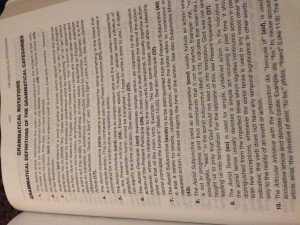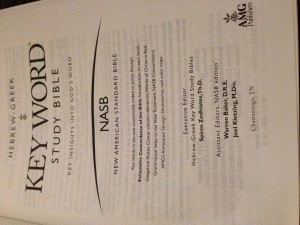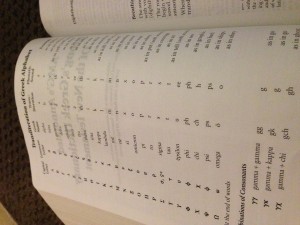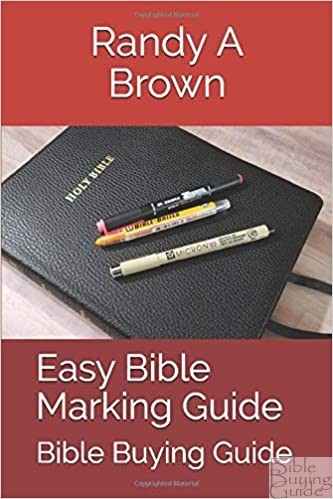There are those Bibles that prove to be excellent resources; they are pocket friendly, have large print, excellent study notes, etc. Then there are Bibles that are in a class by themselves. In an earlier review, I stated that there are very few Bibles that deserve to sit on the same shelf as the Thompson Chain. Well, here it is: The AMG Hebrew-Greek Keyword Study Bible (any version) is one of two Bibles that deserve to sit next to the Thompson. Why, though?
Most Christians are not Hebrew or Greek Scholars and even though some have been to Bible College, they may not remember their lessons. That is where the Hebrew Greek Study Bible comes in to play. For the purposes of this review, I will be talking about the NASB Version in genuine leather. Disclaimer: The NASB is my preferred translation and the translation that I use on a daily basis. Additionally, this Bible was purchased at my own expense, as a replacement for a hardcover NIV Hebrew-Greek Keyword Study Bible, and this review is independent of AMG Publishers.
Before we get into the review…
Why choose an NASB over other translations?
1. The New American Standard Bible translation team adhered to the literal philosophy of translation also known as Formal Equivalence. Formal Equivalence is the most exacting and demanding method of translation, as it requires a word-for-word translation that is accurate and precise, yet easily readable. This philosophy of translation follows the word and sentence patterns of the original authors so that the reader is free to understand God’s message as the Holy Spirit leads. (It should be noted that NASB does arrange the word order so that it makes more sense to an English Speaker. Example:
John 1:1 En arche een ho logos
“In [the] beginning was the Word.”
kai ho logos een pros ton theon
“and the Word was with the God.”
kai theos een ho logos
“and God was the Word.”
While the Greek literally reads God was the word, the NAS translates it as and the Word was God, reflecting the way English is spoken {also notable is the fact that this rendering goes all the way back to KJV at the least.})
2. The translators come from Presbyterian, Methodist, American Baptist, Disciples, Southern Baptist, Nazarene, General Association of Regular Baptist, Congregational, Independent Baptist, Free Methodist, and still other denominations. Some have international reputations. All support the philosophy of literal translation and the doctrinal statement of The Lockman Foundation, including the inerrancy of the Scriptures. (The diverse background of the translators is important because it reduces the risk of bias and/or the perception of bias in favor of any one particular denomination. i.e. I, personally find that the ESV feels very Presbyterian.)
3. GREEK TENSES: A careful distinction has been made in the treatment of the Greek aorist tense (usually translated as the English past, “He did”) and the Greek imperfect tense (normally rendered either as English past progressive, “He was doing”; or, if inceptive, as “He began to do” or “He started to do”; or else if customary past, as “He used to do”). “Began” is italicized if it renders an imperfect tense, in order to distinguish it from the Greek verb for “begin.” In some contexts the difference between the Greek imperfect and the English past is conveyed better by the choice of vocabulary or by other words in the context, and in such cases the Greek imperfect may be rendered as a simple past tense (e.g. “had an illness for many years” would be preferable to “was having an illness for many years” and would be understood in the same way).
On the other hand, not all aorists have been rendered as English pasts (“He did”), for some of them are clearly to be rendered as English perfects (“He has done”), or even as past perfects (“He had done”), judging from the context in which they occur. Such aorists have been rendered as perfects or past perfects in this translation.
As for the distinction between aorist and present imperatives, the translators have usually rendered these imperatives in the customary manner, rather than attempting any such fine distinction as “Begin to do!” (for the aorist imperative), or, “Continually do!” (for the present imperative).
As for sequence of tenses, the translators took care to follow English rules rather than Greek in translating Greek presents, imperfects and aorists. Thus, where English says, “We knew that he was doing,” Greek puts it, “We knew that he does”; similarly, “We knew that he had done” is the Greek, “We knew that he did.” Likewise, the English, “When he had come, they met him,” is represented in Greek by: “When he came, they met him.” In all cases a consistent transfer has been made from the Greek tense in the subordinate clause to the appropriate tense in English.
In the rendering of negative questions introduced by the particle me (which always expects the answer “No”) the wording has been altered from a mere, “Will he not do this?” to a more accurate, “He will not do this, will he?”
Ultimately, Bible Translation is very personal. However, I will say that in order to fulfill the mandate in 2 Timothy 2:15, a Formal Equivalence translation is absolutely critical.
I love and honor the KJV. That being said, it isn’t my personal preference to teach from, though I do reference KJV quite frequently. My choice of NASB is based solely on its literalness.
Features
Bible text of the 1977 NASB
NEW! Wider margins than previous editions
Introduction to each book of the Bible
Words of Christ in Red
Table of Weights and Measures
AMG’s Concordance of the Bible
NEW! AMG’s Annotated Strong’s Dictionaries
Combining Strong’s dictionaries with additional material taken from AMG’s Complete Word Study Dictionaries
Footnotes on the original languages, Bible history, Bible doctrines, and difficult passages
Strong’s numbers on key words in the text of the Bible
Grammatical codes on key words in the text of the New Testament
Used with the Grammatical Notations, these codes identify the forms of Greek grammar behind the English translation
System of Study:
Key Words in the English Text Identified by James Strong’s Numbering System
Codes in the New Testament Text Identify Grammatical Structure of Key Greek Words
Notations Explain the Significance of the Grammatical Codes
Hebrew and Greek Word Studies
Strong’s Hebrew and Greek Dictionaries
Center-column Reference System
Concordance
Product Information
Format: Genuine Leather
Number of Pages: 2156
Vendor: AMG Publishers
Publication Date: 2008
Dimensions: 9.5 X 7.0 X 2.0 (inches)
ISBN: 0899577539 ISBN-13: 9780899577531
Availability: In Stock
References: Center Column
Text Layout: Double Column
Text Color: Red Letter
The NASB is extremely literal, but what if a word has more than one meaning? What if there are nuances that you haven’t considered? What about Hellenistic Culture or the fact that the Bible is a Jewish book? What then? Well, there is an extensive helps section beginning with a guide to grammatical notations used in the text. The concordance provided is the standard NASB concordance provided by the Lockman Foundation (publishers/copyright holders of the NASB). Following the concordance is AMG’s Annotated Strong’s Hebrew Dictionary of the Old Testament including Transliterations of the Hebrew Consonants and Vowels, complete with pronunciation guide. This dictionary is 282 pages (begins on 1789 and ends on 2071). AMG’s Annotated Strong’s Greek Dictionary completes the helps section and is 241 pages (begins on 2077 and ends on 2318)
The study notes are provided by Dr. Spiros Zodhiates the founder of AMG. They are fairly influence free and exhibit mainstream evangelical thought. Unlike most study Bibles, though, this Bible does not provide notes on most passages of the Bible. Rather it provides notes on key passages of scripture and every verse has a keyword noted and linked to the dictionary in the back. On a side note, it is quite useful to understanding the New Testament that Dr. Zodhiates was Greek. Who better to explain a Greek Text than a native Greek?
I am going to borrow a little from Randy’s excellent review of this Bibles twin (ESV) but I will also add some additional thoughts on these sections.
Paper and Font
The paper is actually thicker and more opaque than both the ESV and KJV but equally as thick and opaque as in the NIV; I find that interesting because the NIV is Dynamic Equivalence, also known as though for thought. However, given its popularity, it makes sense that the NIV variant would be comparable to the NASB; in one you have the most literal and in the other, the most popular.
I would guess at a 9.5 point font. The black letters are crisp and easy to see. Sadly, the red is not as crisp as it is in the Thompson. This is not to say that you will have difficulty reading it, although you may have some functional difficulties if you happen to carry this Bible into the pulpit as the viewing angles can be a little tricky
Layout
The text is presented in double column, paragraph format. Poetry is set in verse format. Verse numbers are in bold, making it easy to find verses within the paragraphs. OT quotes in the NT are offset, making them easy to identify. I would love to see the King James Version offered in this format. References are placed in a center column and translation notes are placed under the last verse in that column. Section headings are in italics and bold, and are much larger than the Scripture text. References, translation notes, and section headings are the standard available for ESV. Commentary notes appear at the bottom of the page and are keyed to the text with a verse number and a drawing of a key.
What really makes this Bible different and sets it apart are the grammatical codes and notations. There are numbers, letters, and underlining within the Scripture text. Words that are underlined have the Strong’s number. You can look these numbers up in the dictionary in the back. If the number is bold, the entry will be expanded (annotated). If the number is not bold, it’s just the regular Strong’s entry. Not every word gives the Strong’s number. There are lots of them on every page, but there will always be one that I want to be coded that’s not coded. For these words I have to look them up myself and write the number over the word. Grammatical codes are a string of letters that appear before the word. They are only found in the New Testament. These codes show the part of speech for that word. There is a list of grammatical codes in the back and on a supplied bookmark.
Book Introductions
The book introductions are about a half a page each. They cover the history and customs (limited) of the people the book was written to or about, and gives information of the significance of the book. I cannot speak for others but this is one area that I would have liked to see developed a little more. Since Dr. Zodhiates is, himself, Greek, it would have been very nice to have some material on Greek culture. If nothing else, a 1 page article could have gone a long way towards helping to understand the New Testament better.
Notes Section
The notes at the bottom of the page discuss theological, exegetical, historical, and geographical points from the text. This is not like a standard study Bible with lots of commentary on every page. The main function of this study Bible is to be a linguistic aid rather than a commentary packed into a Bible. If you are looking for commentary, this Bible probably is not for you; if you want to better understand Scripture (especially if you are a Bible teacher) then this is not a should have it is a must have. If I could only have 2 Bibles for the rest of my life, this and the Thompson are what I would choose. Between the two, you will find that you have everything necessary to grow in your knowledge of the Bible and of the Lord.
It could just be me, but I really feel like there are more notes and better notes in the NASB and KJV Versions than there were in my NIV. (I cannot say this about the ESV because I have not looked at it as carefully.) There are certainly more translators notes included in the Bible text and that is part of what sets NASB apart; like the Holman CSB there are extensive translation notes.
Grammatical Codes
The Grammatical Codes section contains a page with all of the codes and 3 pages of examples. The codes show the verb tense forms of the Greek. The information explaining how to use the codes is found in the next section – Grammatical Notations. I would recommend placing the Grammatical Codes after the Grammatical Notations, so the explanation on how to use them comes before the codes themselves. The information is in this Bible, it’s just a little confusing at first because it looks like two separate sections when it really should be one section.
Grammatical Notations
The Grammatical Notations section is 20 pages and explains how to use the Grammatical Codes. The focus is on verbs. It covers the five features of verbs (tense, voice, mood, person, and number. They are written so that anyone can use them). However, they do not take the place of an education in Biblical Greek. Each of the features are explained and plenty of examples are given. They give enough information to be helpful and get you started, but it doesn’t give you everything you need to know. This section is very clear about that and gives references to other works to help learn Koine (New Testament) Greek. This section is the most technical and difficult to use.
This Bible is quite large, and I love that. It’s not a Bible I would generally have in my bag with me, but it sits right next to my Thompson and my computer. Since the day I purchased it, this has been my primary study tool. I cannot recommend it highly enough.

























Matthew,
Great review. Can you tell me if this bible does more than what I can do with bible software? For example, I use Mysword on my andriod tablet next to my open bible. I can easily look up Strong numbers do searches or find cross references without having to flip through my bible.
Does the hebrew-greek key word study bible go beyond this in any way?
Thanks. John
Hi John:
While the answer to your question is essentially no, I need to clarify my remarks a little. Wordsearch, Mysword, esword, Logos, BIbleworks etc are all great resources (I use Wordsearch, Olivetree, and e-sword regularly.) I still do the searches in the Hebrew-Greek Keyword Study Bible primarily because I am very bookish. I love the feel of a book in my hands; reminds me of my school days. Software is great but it just does not feel the same to me.
I digress…use either. Neither one is a wrong choice.
Blessings,
Matt
I really want to buy this Bible but was all for buying it in the NASB until I saw that it is in the 1977 edition, is this true or is it in the 1995 text? I use the ESV for reading but that and the NASB for study.
Hi Cheryl
The 1977 Edition of the NASB (which this is) should not stop you from buying. It is the 1977 edition that is widely considered to be the most literal translation ever made. It is also the edition that has been the academic standard for over 30 years
To Matthew
Many thanks for your reply, I absolutely adore the NASB – whether it be the 1977 or the 1995 edition. I use the NASB everyday for study and also the ESV too. I enjoy the latter for the reading too.
I received my copy of this Bible today and I got the ESV edition. It sits on top of both my NASB International Inductive Study Bible and my ESV Personal Reference Bible. I very rarely use the NIV or the NLT these days.
Hi Cheryl-Lee. You’ve got a good assortment of Bibles and tools for an enriched study of God’s Word. The Inductive Study Bible is another of my favorites. I can highly recommend the ESV edition: https://biblebuyingguide.com/inductive-study-bible-esv-review/
I am about to purchase the Key Word Study Bible NASB (2008 new edition) Genuine Black. I would like to know how it compares to the 1977 edition please?
Thanks
Joe
Joseph:
The text itself is the NASB 1977. This is the 2008 reprint of the Hebrew-Greek Bible. It has larger font and updated language tools and notes. Hope that helps
Thanks for the quick reply. I definitely will get this Bible soon!
Joe
Could you please let me know if this Bible includes maps? Thanks
Joe
Hi Matthew!
Very helpful and thorough review! I think I found the Bible I’m looking for! Quick question: are there any other Bibles out there with more comprehensive references to Strong’s?
More details: You said “Not every word gives the Strong’s number. There are lots of them on every page, but there will always be one that I want to be coded that’s not coded. For these words I have to look them up myself and write the number over the word.” I’ve fallen in love with biblehub.com and their NASB bible that lets you click on any word to get the Hebrew/Greek definition and references. I’m looking for a physical Bible that provides a similar experience, and it looks like this is it, or closest to it. I don’t mind coding the rest of the necessary words, as you did. But if there’s a version where I won’t have to, that would be even better. Is there one that you know of? Thanks!
Christian
Hi Christian:
To my knowledge, there is not a more comprehensive set of resources than those offered by AMG. The Hebrew-Greek Keyword Study Bible is the gateway resource and then they have a 2-volume set, the Complete Word Study Old Testament and the Complete Word Study New Testament. I have not been able to review the other two but I have seen them in a friend’s office. I think they will suit your needs but they will probably remain on your desk as opposed to being carried with you
Thanks you so much for your quick response! Thanks for pointing me toward the two-volume set, for some reason I thought those were just components of the “key word study bible.” I’ll have to check those out too. Thanks again!